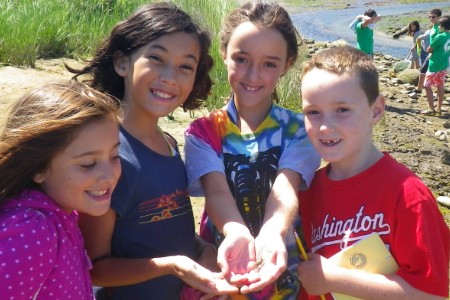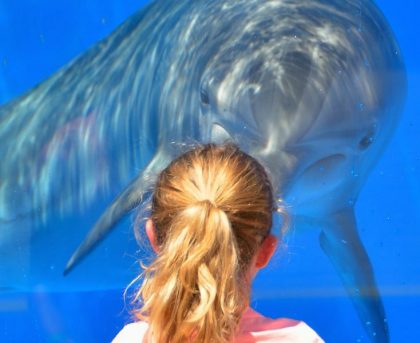
School
On guided tours of the fish hatchery, school groups will learn about freshwater ecosystems. Students will discover how fish swim and breathe underwater, learn about predator/prey relationships, see an egg stripping demonstration, and more. Programs can be customized to fit your curriculum needs.
supports classroom learning in:
Science.
topics covered:
Aquatic habitats, water cycle, freshwater ecology, hibernation, metamorphosis, fertilization, hatchery breeding, food web, endangered species.
contact info
Name: Krissy Forman
Email: [email protected]
INFO
ABOUT
Cold Spring Harbor Fish Hatchery & Aquarium
Visit Cold Spring Harbor Fish Hatchery & Aquarium, home of the largest living collection of New York State freshwater reptiles, fishes, and amphibians. Groups of all ages will enjoy seeing live animal displays at the aquarium’s two buildings and eight outdoor ponds. Guided tours allow groups to feed trout, come face to face with turtles, and witness fish breeding. Groups will also see plants, birds, and butterflies in the outdoor exhibit areas. Educational programs focus on topics such as aquatic animal habitats, animal adaptations, life cycles, ecology, egg stripping, and more.
contact info
Hrs: Daily, 10AM-5PM.
HELPFUL LESSON PLAN(S)
Prepared by FieldTripDirectory.com
Aquarium Lesson Plan
FUN FACTS
• Did you know a sea cucumber can shoot its intestines at predators, and then regrow them, in order to avoid being eaten?
• An electric eel can produce 500 watts of electricity (that’s enough to light up 10 light bulbs) to frighten away predators.
• Dolphins sleep with one half of the brain and one eye open to watch for danger.
• No matter how many pieces you cut a sea sponge into each piece will continue living and growing.
• Ocean life can do amazing things to survive. As you visit an aquarium with your students, note the different ways animals defend themselves. Just like a squid, people wouldn’t bother you either if you squirted black ink in their face!
View Lesson Plan>>
Scouts
Scout groups can work on science-related badges while visiting the Cold Spring Harbor Fish Hatchery & Aquarium. Programs allow scouts to try their hand at fishing, complete a scavenger hunt while hiking through a local preserve, collect and examine samples from the Spring Pond, and more. Scout programs can be customized to meet badge requirements.
supports scout badges in:
Science.
topics covered:
Aquatic habitats, water cycle, freshwater ecology, hibernation, metamorphosis, fertilization, hatchery breeding, food web, endangered species.
contact info
Name: Krissy Forman
Email: [email protected]
INFO
ABOUT
Cold Spring Harbor Fish Hatchery & Aquarium
Visit Cold Spring Harbor Fish Hatchery & Aquarium, home of the largest living collection of New York State freshwater reptiles, fishes, and amphibians. Groups of all ages will enjoy seeing live animal displays at the aquarium’s two buildings and eight outdoor ponds. Guided tours allow groups to feed trout, come face to face with turtles, and witness fish breeding. Groups will also see plants, birds, and butterflies in the outdoor exhibit areas. Educational programs focus on topics such as aquatic animal habitats, animal adaptations, life cycles, ecology, egg stripping, and more.
contact info
Hrs: Daily, 10AM-5PM.
HELPFUL LESSON PLAN(S)
Prepared by FieldTripDirectory.com
Aquarium Lesson Plan
FUN FACTS
• Did you know a sea cucumber can shoot its intestines at predators, and then regrow them, in order to avoid being eaten?
• An electric eel can produce 500 watts of electricity (that’s enough to light up 10 light bulbs) to frighten away predators.
• Dolphins sleep with one half of the brain and one eye open to watch for danger.
• No matter how many pieces you cut a sea sponge into each piece will continue living and growing.
• Ocean life can do amazing things to survive. As you visit an aquarium with your students, note the different ways animals defend themselves. Just like a squid, people wouldn’t bother you either if you squirted black ink in their face!
View Lesson Plan>>
Homeschool
Homeschool groups will learn about a variety of topics regarding freshwater ecology at the fish hatchery. Programs and activities focus on animal adaptations, how aquatic wildlife hibernate in frozen ponds, predator/prey relationships, and more.
topics covered:
Aquatic habitats, water cycle, freshwater ecology, hibernation, metamorphosis, fertilization, hatchery breeding, food web, endangered species.
contact info
Name: Krissy Forman
Email: [email protected]
INFO
ABOUT
Cold Spring Harbor Fish Hatchery & Aquarium
Visit Cold Spring Harbor Fish Hatchery & Aquarium, home of the largest living collection of New York State freshwater reptiles, fishes, and amphibians. Groups of all ages will enjoy seeing live animal displays at the aquarium’s two buildings and eight outdoor ponds. Guided tours allow groups to feed trout, come face to face with turtles, and witness fish breeding. Groups will also see plants, birds, and butterflies in the outdoor exhibit areas. Educational programs focus on topics such as aquatic animal habitats, animal adaptations, life cycles, ecology, egg stripping, and more.
contact info
Hrs: Daily, 10AM-5PM.
HELPFUL LESSON PLAN(S)
Prepared by FieldTripDirectory.com
Aquarium Lesson Plan
FUN FACTS
• Did you know a sea cucumber can shoot its intestines at predators, and then regrow them, in order to avoid being eaten?
• An electric eel can produce 500 watts of electricity (that’s enough to light up 10 light bulbs) to frighten away predators.
• Dolphins sleep with one half of the brain and one eye open to watch for danger.
• No matter how many pieces you cut a sea sponge into each piece will continue living and growing.
• Ocean life can do amazing things to survive. As you visit an aquarium with your students, note the different ways animals defend themselves. Just like a squid, people wouldn’t bother you either if you squirted black ink in their face!
View Lesson Plan>>
